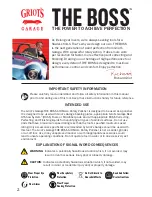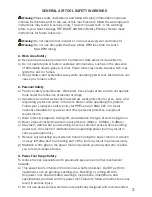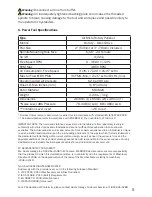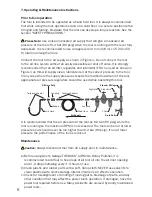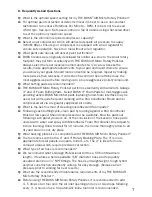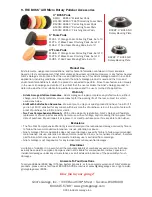
4
by Griot’s Garage. Just because the accessory can be attached to the power tool
does not assure safe operation.
c) Do not use damaged buffing pads and accessories on power tool. Compromised
accessories can fail and cause injury.
d) Disconnect the power tool from air source before making any adjustments,
changing accessories, or storing the power tool. Such preventive safety
measures reduce the risk of starting the power tool accidentally.
e) Never lay the power tool down until the spinning accessory has come to a
complete stop. It may grab the surface and pull the power tool out of your
control.
f) Do not run the power tool while carrying it at your side. Accidental contact with
the spinning accessory could snag your clothing and pull the accessory into your
body.
g) Keep hands, hair and clothing away from the working end of the tool.
h) Do not touch the rotating parts during operation for any reason.
i) Never operate this tool without all guards or safety features in place and in
proper working order.
j) Be aware that incorrectly installed hoses and fittings might unexpectedly come
loose at any time and create a whipping/impact hazard.
k) If you notice any abnormal noise or vibration when operating the product,
immediately discontinue its use and inspect for worn or damaged backup pad.
Replace any damaged parts. If abnormal noise or vibration still exists, return for
service or repair. Refer to warranty instructions.
POWER TOOL SET-UP
4. Installing The Rotary Backing Plate:
a) Disconnect air line from buffer.
b) Place supplied wrench on output shaft.
c) With compression washer installed, align threaded hub of backing plate to THE
BOSS
™
female hub.
d) Turn the backing plate clockwise by hand, tighten firmly.
5. Removing & Mounting Buffing/Disc Pad
a) Disconnect air line from buffer.
b) Peel the old buffing pad from the backing plate, by lifting an edge and pulling
firmly upward.
c) Inspect the hook material on the disc pad for damage or debris clogging the
hooks. Clean any debris or buffing compound from the backing plate surface.
d) Attach a new buffing pad to the backing plate, being careful to center it as well
as possible.
e) Apply hand pressure to engage the hook and loops to firmly seat the buffing pad.
6. Setting Tool Speed
Set maximum speed (RPM) by applying an appropriate flat-blade screwdriver to
speed control on top of tool handle. Set screwdriver aside, turn machine on to
verify appropriate speed using a non-surface tachometer. Never exceed more
than 2,500 rpm free-spin. Set speed control prior to use, as conditions may vary.


